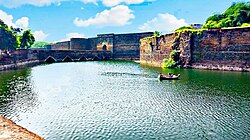| Suraj Mal | |
|---|---|
| Maharaja of Bharatpur | |
 | |
| Maharaja of Bharatpur | |
| Reign | 23 May 1755 – 25 December 1763 |
| Coronation | Deeg, 23 May 1755 |
| Predecessor | Badan Singh |
| Successor | Jawahar Singh |
| Born | 13 February 1707 Bharatpur |
| Died | 25 December 1763 (aged 56) near Delhi |
| Wives | Maharani Kishori[1] Rani Gauri[1] |
| Issue | Jawahar Singh Nahar Singh Ratan Singh Nawal Singh Ranjit Singh |
| House | Sinsinwar Jat Dynasty |
| Father | Badan Singh Jat[2] |
| Mother | Maharani Devki |
| Religion | Hinduism |
Maharaja Suraj Mal (13 February 1707 – 25 December 1763), simply known as Suraj Mal, was a Jat ruler of Bharatpur State in the present-day state of Rajasthan.[3] Under him, Bharatpur State, a tributary of the House of Scindia,[4] covered the present-day districts of Agra, Alwar, Aligarh, Bharatpur, Dholpur, Etawa, Hathras, Mainpuri, Meerut, Ghaziabad, Mathura, and Rohtak, Sonipat, Jhajjar, Nuh, Palwal, Faridabad, Kasganj, Mainpuri, Firozabad, Bulandshahr.[5][6][7][8][9]
A contemporary historian had described him as "the Plato of the Sinsinwar Jat tribe" and by a modern writer as the "Jat Ulysses", because of his "political sagacity, steady intellect and clear vision."[10] The people, under Suraj Mal, overran the Mughal garrison at Agra.[11] In addition to the troops stationed at his forts, he had an army of more than 75,000 infantry and more than 38,000 cavalry.[11]
Lohagarh Fort is one of the well-known forts located in Bharatpur city of Rajasthan which was built by Maharaja Suraj Mal in 1732 on an artificial island and took eight years to complete. He is famous for building other such forts and palaces in his kingdom. It needed large number of manpower and significant amount of wealth to build such impregnable fort, as the name of the fort itself says-- “Lohagarh”, which means, Iron fort (Loha means Iron and Garh means fort).[12] Lohagarh Fort is considered as one of the strongest fort as British forces led by Lord Lake could not capture it in spite of several attacks during the Siege of Bharatpur. Lord Lake made a siege of the fort in 1805 for six weeks but in spite of so many attacks he couldn’t annex it.[13] Later between December 1825 and January 1826, British troops under Lord Combermere initially surrounded the state's capital until on 18 January 1826 its fortress was stormed and captured. After this siege, Bharatpur became princely state under British Raj control.[14]
Deeg Palace is a Palace in Deeg & 32 km from city of Bharatpur in Deeg District in Rajasthan, India. It was built in 1730 [15] by Maharaja Suraj Mal as a luxurious summer resort for the rulers of Bharatpur State.
- ^ a b Dwivedi, Girish Chandra (1989). The Jats, Their Role in the Mughal Empire. Arnold Publishers. p. 238. ISBN 978-81-7031-150-8.
... (i) Rani Kishori, the daughter of Chowdhari Kashi Ram of Hodal. She was issueless. ... (v) Rani Gauri, she originated from Gori Rajput clan of Amahand and was the mother of Jawahar and Ratan Singh.
- ^ Sarkar, Jadunath (1950). Fall of the Mughal Empire, volume 2. p. 43.
- ^ Yadav, Jyoti (25 April 2023). "Ambedkar vs Jat king Surajmal, a battle of two statues — why a sleepy Rajasthan town is on the boil". ThePrint. Retrieved 26 May 2024.
- ^ Sunderlal, Pandit (2018). How India Lost Her Freedom. SAGE Publishing. p. 500. ISBN 9789352806423.
- ^ Chaudhuri, J. N. (1977). "Disruption of the Mughal Empire: The Jats". In Majumdar, R. C. (ed.). The History and Culture of the Indian People. Vol. 8: The Maratha Supremacy. Bharatiya Vidya Bhavan. p. 157. OCLC 1067771105.
During his regime the Jāt State reached its highest extent. Besides the original Bharatpur principality, it embraced the districts of Āgra, Dholpur, Mainpuri, Hathras, Aligarh, Etawa, Mirat, Rohtak, Farrukhnagar, Mewāt, Rewari, Gurgaon, Ghaziabad and Mathurā.
- ^ Sharma, Gautam (1990). Valour and Sacrifice: Famous Regiments of the Indian Army. Allied Publishers. ISBN 978-81-7023-140-0. Archived from the original on 15 February 2024. Retrieved 15 February 2024.
- ^ Ahmad, Dr Aijaz (9 July 2021). History of Mewat. Alina Books. ISBN 978-81-933914-2-6. Archived from the original on 15 February 2024. Retrieved 15 February 2024.
- ^ Mehta, Jaswant Lal (1 January 2005). Advanced Study in the History of Modern India 1707-1813. Sterling Publishers Pvt. Ltd. ISBN 978-1-932705-54-6.
- ^ "Maharaja Surajmal Jat : राजस्थान के अजेय जाट महाराज जिन्होने अकबर की कब्र को खोद दिया था". Zee News (in Hindi). Retrieved 11 May 2024.
- ^ R.C.Majumdar, H.C.Raychaudhury, Kalikaranjan Datta: An Advanced History of India, fourth edition, 1978, ISBN 0-333-90298-X, Page-535
- ^ a b Chaudhuri, J. N. (1977). "Disruption of the Mughal Empire: The Jats". In Majumdar, R. C. (ed.). The History and Culture of the Indian People. Vol. 8: The Maratha. Bharatiya Vidya Bhavan. p. 157. OCLC 1067771105. Retrieved 20 December 2019.
- ^ "Lohagarh Fort". 10 February 2024.
- ^ "Lohagarh Fort: कोई नहीं जीत पाया ये किला, 13 बार हमले के बाद अंग्रेज भी हो गए थे असफल". 5 February 2024.
- ^ "Siege of Bharatpur, 1825-1826". 5 May 2024.
- ^ History of Deeg Palace in Bharatpur

